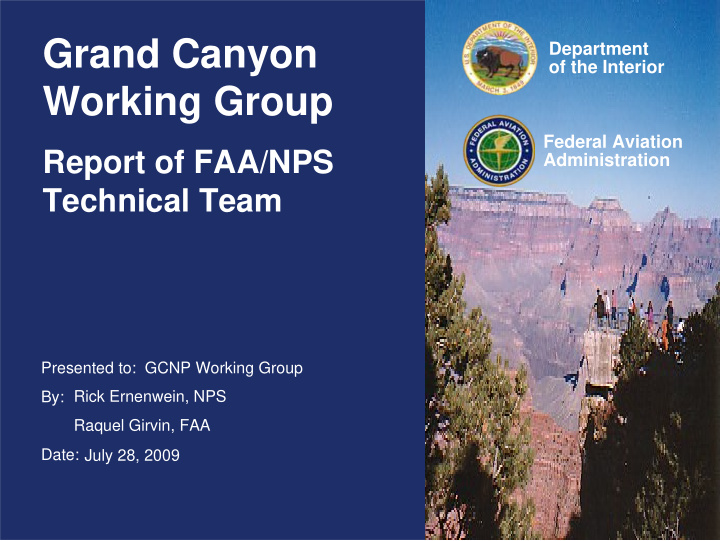



Grand Canyon Department of the Interior Working Group Federal Aviation Report of FAA/NPS Administration Technical Team Presented to: GCNP Working Group By: Rick Ernenwein, NPS Raquel Girvin, FAA Date: July 28, 2009
Background • NPS and FAA formed a Technical Team to assist the agencies with noise assessment for the GRCA EIS in the near term, and for the Air Tour Management Plans in the longer term • Members at completion of Technical Team report: – NPS, Natural Sounds Program Office: Kurt Fristrup – NPS, Grand Canyon National Park: Ken McMullen – NPS, Grand Canyon National Park: Laura Levy – NPS, Grand Canyon National Park: Rick Ernenwein – FAA, Office of Environment and Energy, Noise Division: Raquel Girvin – FAA, Office of Environment and Energy, Noise Division: Rebecca Cointin – FAA Las Vegas Flight Standards District Office: Paul Joly – Volpe National Transportation Systems Center: Cynthia Lee Department FAA/NPS Technical Team Report Federal Aviation Federal Aviation 2 of the Interior Administration Administration July 28, 2009
Process • NPS members of the Technical Team proposed a framework for evaluating the impacts of aircraft noise at GCNP in the form of four matrices containing metrics or indicators and corresponding thresholds for impact intensities: – Visitor experience opportunities (ground-based); – Soundscape; – Threatened and endangered species/wildlife; – Ethnographic resources. • After an initial review of the proposed framework and referenced literature, the Technical Team agreed that expert opinion would benefit the review • NPS and FAA convened experts for discussions via teleconference and email Department FAA/NPS Technical Team Report Federal Aviation Federal Aviation 3 of the Interior Administration Administration July 28, 2009
Expert Panelists • Visitor Experience Expert Panel – David N. Cole, Forest Service Research Scientist, Aldo Leopold Wilderness Research Institute in Missoula, MT – James Gramann, Visiting Chief Social Scientist of the National Park Service – James Fields, Independent researcher and consultant on social survey, statistical, and community noise issues – Britton Mace, Associate Professor, Department of Psychology, Southern Utah University – Robert Manning, Professor, Rubenstein School of Environment and Natural Resources, University of Vermont – Kevin Shepherd, Acoustics Researcher, NASA Langley Research Center, Hampton, VA • Wildlife Expert Panel – Ann E. Bowles, Senior Research Scientist at the Hubbs-SeaWorld Research Institute – Ed Cleary, Wildlife Society Certified Wildlife Biologist, owner of WASHMan LLC Consulting – Robert J. Dooling, Professor, University of Maryland’s Department of Psychology – Darlene Ketten, Marine Biologist and Neuro-anatomist specializing in biomedical imaging of sensory systems – Paul R. Krausman, Boone and Crockett Professor at the University of Montana – Gail L. Patricelli, Assistant Professor, Department of Evolution and Ecology, University of California, Davis Department FAA/NPS Technical Team Report Federal Aviation Federal Aviation 4 of the Interior Administration Administration July 28, 2009
Outcome of Expert Panel Telecons • The expert panels discussed outstanding questions and gaps in scientific knowledge in our general understanding of the impacts of noise on park visitors and wildlife. • Among issues discussed: – A variety of metrics is useful; different metrics capture different components of the environment.(11)* – It is not clear that science alone can provide the judgment that some level of impact is a specific impact intensity level… As a result, the choice of thresholds involves a large amount of policy judgment.(18) – Correlations among metrics and sites should be studied; some metrics may be redundant, and similarities among sites can be used to condense the associated explanation.(12) – Interpretation of time above metrics should consider what the background ambient levels are.(13) – There were divergent thoughts regarding the merits of speech interference metrics, and what scientific or conventional support there was for choosing a specific level.(14) – Analysis of wildlife impacts should consider the spectrum of the noise in relation to the spectra of the biological signals of interest.(10) – The assembled literature provides an incomplete basis for developing a quantitative impact analysis framework. (5) * Numbers correspond to discussion item numbers in Section 3 of the Final Report. Department FAA/NPS Technical Team Report Federal Aviation Federal Aviation 5 of the Interior Administration Administration July 28, 2009
Technical Team Conclusions • Gaps in scientific knowledge pose problems for developing a scientific consensus to identify the best noise metrics and support impact intensity thresholds for the GCNP EIS. • Technical Team members did not agree on the use of the proposed set of quantitative impact intensity thresholds, or on any quantitative framework for analyzing impacts. However, they – Recommended that the EIS analysis could proceed by comparing alternatives using a variety of metrics – Reached consensus regarding metrics that would provide useful information Department FAA/NPS Technical Team Report Federal Aviation Federal Aviation 6 of the Interior Administration Administration July 28, 2009
Next Steps With both agencies acknowledging the need for a comprehensive aircraft noise effects research program, the Team recommended to: – Develop a systematic strategy for engaging the scientific community, recommending that • A wildlife roadmapping workshop be held similar to the October 2008 roadmapping workshop on “Human Response to Aviation Noise in Protected Natural Areas” • The agencies support an independent and authoritative scientific organization to identify the best bases for evaluating noise impacts at present, and to recommend research projects that would decisively reduce uncertainties and fill data gaps. – Establish a FAA-NPS research steering group to: • Provide for regular communication about research initiatives and results; • Identify areas of common research interests; and • Develop plans for coordinated research approach, including funding. Department FAA/NPS Technical Team Report Federal Aviation Federal Aviation 7 of the Interior Administration Administration July 28, 2009
Technical Team Report • Final report documenting Technical Team work was completed and delivered to GCNP NEPA Team on 9 June 2009 with erratum page dated 17 July 2009 Department FAA/NPS Technical Team Report Federal Aviation Federal Aviation 8 of the Interior Administration Administration July 28, 2009
Recommend
More recommend